Global Non Small Cell Lung Cancer Market Research, 2031
The global non small cell lung cancer market size was valued at $15.3 billion in 2021, and is projected to reach $36.9 billion by 2031, growing at a CAGR of 9.3% from 2022 to 2031.
Non-small cell lung cancer is a type of lung cancer, in which malignant tumor cells are formed in the lungs. It includes group of different diseases, which behave similarly such as squamous cell carcinoma, adenocarcinoma, and large cell carcinoma. Adenocarcinoma is a type of non-small cell lung cancer, which is more common in women than men and more in young people than old age group of people. It is found common in people who have a history of smoking and those who are exposed to polluted air more than those who smoke regularly. Squamous cell carcinoma is another common type of non-small cell lung cancer, which mostly occurs due to smoking tobacco. It mostly occurs in the central part of the lungs, which is near to the main airway. Large cell carcinoma can be harder to treat as it can be found in any part of the lung and tends to spread faster than the rest of the two.
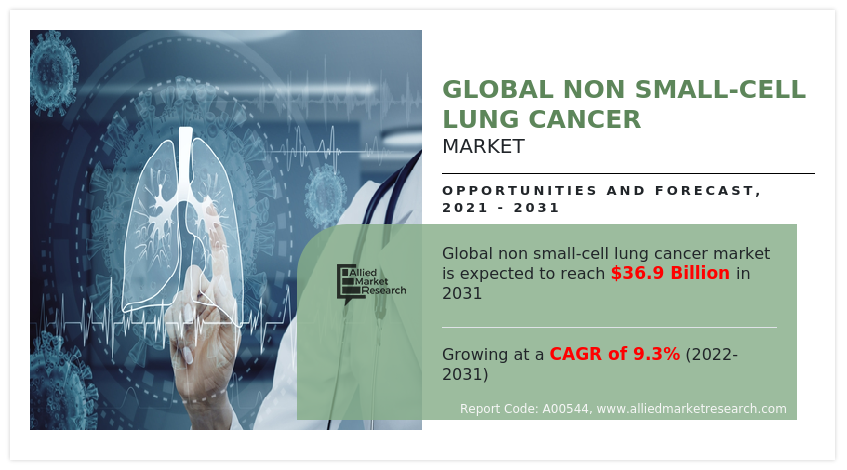
Historical overview
The market was analyzed qualitatively and quantitatively from 2021-2031. The non-small cell lung cancer market grow at a CAGR of around 9.3% from 2021-2031. Most of the growth was derived from the Asia-Pacific region owing to the improving health awareness, rise in disposable incomes, as well as well-established presence of domestic companies in the region.
Market dynamics
The non small cell lung cancer market growth is majorly driven by increase in rate of tobacco consumption more by young group of people, intense air pollution, and unhealthy lifestyle. Exposure to air containing traces of metals such as asbestos, arsenic, and others, are major reasons of adenocarcinoma. Thus, increase in number of people smoking and following unhealthy lifestyle are some of the major factors causing NSCLC. Also, among all lung cancer cases, majority of patients are suffering from non-small cell lung cancer. For instance, according to National Centre for Biotechnology Information (NCBI), 85% of cases are non-small cell lung cancer cases. In addition, increase in research and development activities by key players such as Roche and Eli Lilly propels the growth of the market. The rise in prevalence of lung cancer drive the market growth. The increase in prevalence of lung cancer, which led to rise in demand for non-small cell lung cancer treatment. Non-small cell lung cancer makes for 80–85% of all lung cancer cases globally, owing to exposure to air pollution, active smoking, drinking tainted water, and passive smoking. However, it is treatable with a variety of medicines, including immunotherapy, targeted therapy, and others. Furthermore, excessive consumption of tobacco which causes the cancer is the key factor that propels the market growth. Two main causes of non-small cell lung cancer are excessive tobacco use and active participation in passive smoking. For instance, according to the (World Health Organization) WHO, in 2020, 22.3% of the global population used tobacco, 36.7% of all men and 7.8% of the world’s women. Additionally, rise in prevalence of the non-small cell Lung cancer supports the market growth. For instance, non-small cell Lung cancer makes up around 25% of cancer deaths in the U.S. In 2021, 1,898,160 new cancer cases and 608,570 cancer deaths were projected to occur in the U.S. Long-term air pollution exposure promotes the development of non-small cell lung cancer.
Furthermore, rise in prevalence of lung cancer occur in people who smoke and consume tobacco further contributes toward market growth. Smoking, environmental toxins, radiation exposure, and dietary supplement use are a few risk factors associated with lung cancer. For instance, according to the World Health Organization (WHO), about 2.21 million new instances of lung cancer reported across the globe in 2020, making it the second most frequent type of cancer globally.
However, high-cost expenditure in the treatment of non-small cell lung cancer negatively impacts the growth of the market. In addition, high costs associated with non-small cell lung cancer treatment impedes the market growth. Furthermore, stringent government rules for product approval hinders the growth of the market.
The outbreak of COVID-19 has disrupted workflows in the healthcare sector around the globe. Nearly all industries were impacted by COVID-19. Coronavirus crises led to strictly follow the social distancing rules, and visit hospitals only for emergency need have resulted in a significant decline in demand for treatment services from hospitals. This was expected to negatively affect the demand for treatment services of non-small cell lung cancer. The outbreak of COVID-19 impacted the market, as hospital and healthcare services were significantly reduced due to social distancing measures taken by governments to stop COVID-19 spread. The disease has forced a number of industries to shut their doors temporarily, including several sub-domains of healthcare. Moreover, there has also been a negative effect on various services, including orthopedic implants. For instance, according to the Commonwealth Fund, it was estimated that there was nearly 60% initial decrease in overall outpatient visits by May 2020 due to COVID-19. This was expected to negatively affect the demand for orthopedic sessions as they are usually conducted in outpatient departments. In addition, according to an article published in Europe PMC, the pandemic affected outpatient clinics, emergency and elective surgery, rehabilitation, resident training, personnel management, use of personal protective equipment, telemedicine, and all sub-specialties of orthopedics.
The overall impact of COVID-19 pandemic remained negative for key players in the non small cell lung cancer industry. The decline is due to decrease in number of patients diagnosed with non-small cell lung cancer in 2020 owing to lockdown restrictions along with disruption of supply chain during pandemic resulting in shortage of therapeutics.
Segmental Overview
The non-small cell lung cancer market is segmented on basis of type, treatment type, distribution channel, and region. By type, it is segmented into adenocarcinoma, squamous cell carcinoma, large cell carcinoma and others. By treatment type, it is divided into chemotherapy, immunotherapy, and targeted therapy. By distribution channel, it is segmented into hospital, drug stores and retail pharmacy, and online pharmacy. Region-wise, the market is studies across North America, Europe, Asia-Pacific, and LAMEA.
By type: the adenocarcinoma segment held a major non small cell lung cancer market share in 2021, due to presence of large patient population suffering with adenocarcinoma and availability of broad portfolio of therapeutics for this indication. The squamous cell carcinoma segment is expected to register higher CAGR during the forecast period. For instance, according to American Gastroenterological Association, there were an estimated 604,100 new cases of esophageal cancer in 2020.
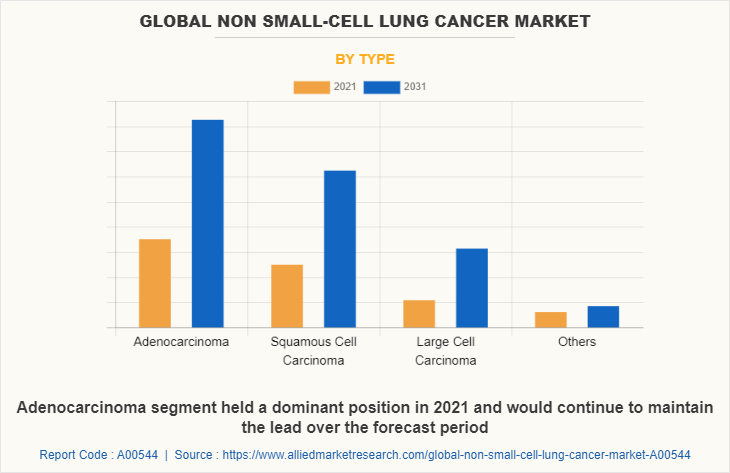
By treatment: the targeted therapy segment dominated the market in 2021 and is expected to continue this trend during the forecast period owing to distinct clinical benefits offered by this therapy such as minimal side effects along with availability of number of targeted therapeutics. In addition, rise in number of people turning to targeted therapy as a form of treatment for cancer, and targeted therapy is successful in upto 80% of cases. On the other hand, immunotherapy segment is expected to witness significant market growth from 2022 to 2031.
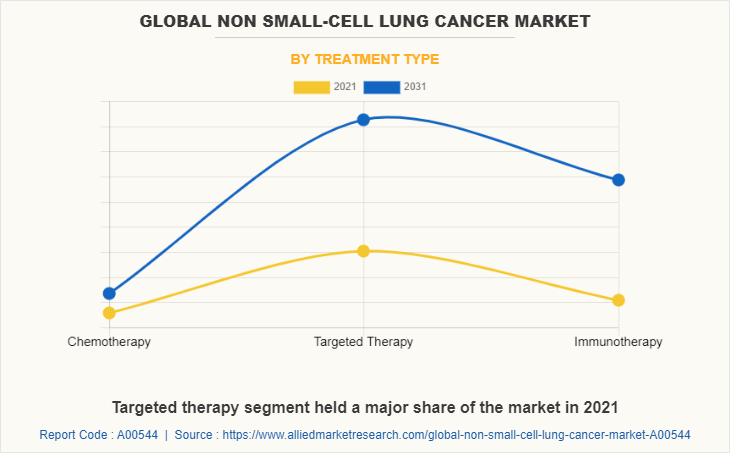
By distribution channel- Hospital pharmacy segment held a dominant share in 2021, and is anticipated to continue this trend during the forecast period. The dominance is due to increase in number of hospitalizations of patients suffering with NSCLC and presence of skilled professionals within these settings.
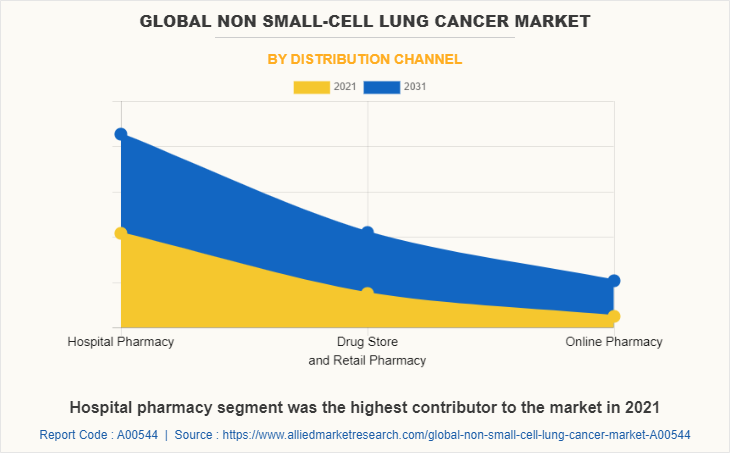
By region: The non small cell lung cancer market size is analyzed across North America, Europe, Asia-Pacific, and LAMEA. North America accounted for a major share of the Non-small cell lung cancer market in 2021, and is expected to maintain its dominance during the forecast period.
The North America market was dominant, in terms of non small cell lung cancer market share in 2021, owing to well-established healthcare infrastructure, higher awareness among people regarding early diagnosis of cancer, presence of favorable reimbursement policies and strong presence of key players in this region.
Presence of several major players in the region drive the growth of the market. In addition, surge in concern among people for maintaining а healthy lifestyle and increase in the demand for non-small cell lung cancer treatments in the region, which is expected to propel the growth of the market. Furthermore, presence of well-established healthcare infrastructure, and increase in adoption rate of various therapies for non-small cell lung cancer are expected to drive the market growth.
On the other hand, Asia-Pacific expected to witness considerable growth during non small cell lung cancer market forecast, due to presence of large patient population and rise in research and development activities in the pharmaceutical sector. Asia-Pacific expected to grow at the highest rate during the forecast period. The market growth in this region is attributable to presence of companies in the region as well as growth in the purchasing power of populated countries, such as China and India. Moreover, rise in adoption of therapies for cancer and adoption of high-tech processing to improve the training program drive the growth of the market. Asia-Pacific offers profitable opportunities for key players operating in the non-small cell lung cancer market, thereby registering the fastest growth rate during the forecast period, owing to the growing infrastructure of industries, rise in disposable incomes, as well as well-established presence of domestic companies in the region. In addition, rise in organizations for cancer awareness within the region provides great opportunity for new entrants in this region. Moreover, increase in number of initiatives and significant investments from governments for the overall development of healthcare system propels growth of the non-small cell lung cancer market in developing countries.
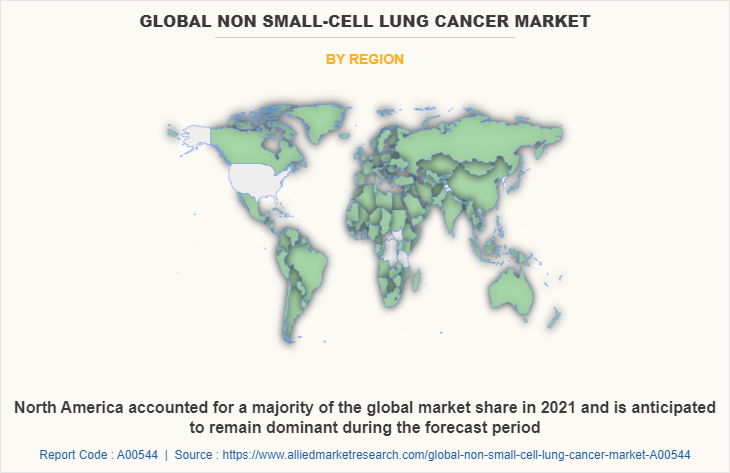
COMPETITION ANALYSIS
Competitive analysis and profiles of the major players in the non small cell lung cancer industry, such as AstraZeneca PLC, Bristol-Myers Squibb Company, Inc., Eli Lilly, F. Hoffmann-La Roche Ltd., Merck & Co., Novartis AG, Inc., Pfizer Inc., Johnson and Johnson, Sanofi S.A, and Teva Pharmaceuticals Industries LTD. The key players that provides the non-small lung cancer treatment products propels the market growth. The some other key market players in the non-small cell lung cancer treatment such as Celgene Corporation, Astellas Pharmaceuticals, and Boehringer Ingelheim Pharmaceuticals, Inc., and others that provides the non-small lung cancer treatment products.
Some example of product approval in the market
In May 2021, Roche announced the approval of Tecentriq by European Commission to enhance product portfolio. Tecentriq was used for first line treatment for adults with metastatic non-small cell lung cancer.
Key Benefits For Stakeholders
- This report provides a quantitative analysis of the market segments, current trends, estimations, and dynamics of the global non small cell lung cancer market analysis from 2021 to 2031 to identify the prevailing global non small cell lung cancer market opportunity.
- Market research is offered along with information related to key drivers, restraints, and opportunities.
- Porter's five forces analysis highlights the potency of buyers and suppliers to enable stakeholders make profit-oriented business decisions and strengthen their supplier-buyer network.
- In-depth analysis of the global non small cell lung cancer market segmentation assists to determine the prevailing market opportunities.
- Major countries in each region are mapped according to their revenue contribution to the global market.
- Market player positioning facilitates benchmarking and provides a clear understanding of the present position of the market players.
- The report includes the analysis of the regional as well as global non small cell lung cancer market trends, key players, market segments, application areas, and market growth strategies.
Global Non Small-Cell Lung Cancer Market Report Highlights
| Aspects | Details |
| Market Size By 2031 | USD 36.9 billion |
| Growth Rate | CAGR of 9.3% |
| Forecast period | 2021 - 2031 |
| Report Pages | 262 |
| By Type |
|
| By Treatment Type |
|
| By Distribution Channel |
|
| By Region |
|
| Key Market Players | Novartis AG, Pfizer Inc., Astrazeneca, Sanofi, boehringer ingelheim, F. Hoffmann-La Roche Ltd, Bristol-Myers Squibb Company, Eli Lilly and Company, Merck & Co., Inc., Celgene Corporation |
Analyst Review
This section provides various opinions of the top-level CXOs in the non-small cell lungs cancer treatment market. In accordance to several interviews conducted, the adoption of non-small cell lungs cancer treatment market is expected to witness a significant rise with increase in prevalence of non-small cell lung cancer diseases and rapid growth in geriatric population with lung problems. The non-small cell lungs cancer treatment market has piqued the interest of healthcare providers, owing to numerous benefits offered by various key players to treat disorders. As the market is saturated with steady growth rate in developed nations, the Asia-Pacific region is expected to offer high growth opportunities to the key players.
According to the perspectives of CXOs of leading companies in the market, rise in incidence of non-small cell lung cancer, surge in geriatric population across the globe, technological advancements, and improvement of healthcare infrastructure in emerging nations are some of the major factors that drive the market growth. However, high cost of NSCLC medications and treatments is a significant inhibitor of market expansion. Also, few drugs have a deleterious effect on the body and several side effects, including anemia, appetite loss, edema, and fertility problems, further hampering the adoption rate.
Factors such as increase in prevalence of lung cancer around the globe, along with rise in investment for R&D by public and private players are the key growth factor for the market.
The forecast period for Non-small Cell Lung Cancer Treatmenrt market is 2022 to 2031
North America is the largest regional market for Global Non Small Cell Lung Cancer
The market value of Non-small Cell Lung Cancer Treatmenrt market in 2022 is $36,934.19 million.
Top companies such as F. Hoffmann-La Roche Ltd, Astrazeneca, and Merck & Co., Inc. held a high market position in 2021.
Loading Table Of Content...


